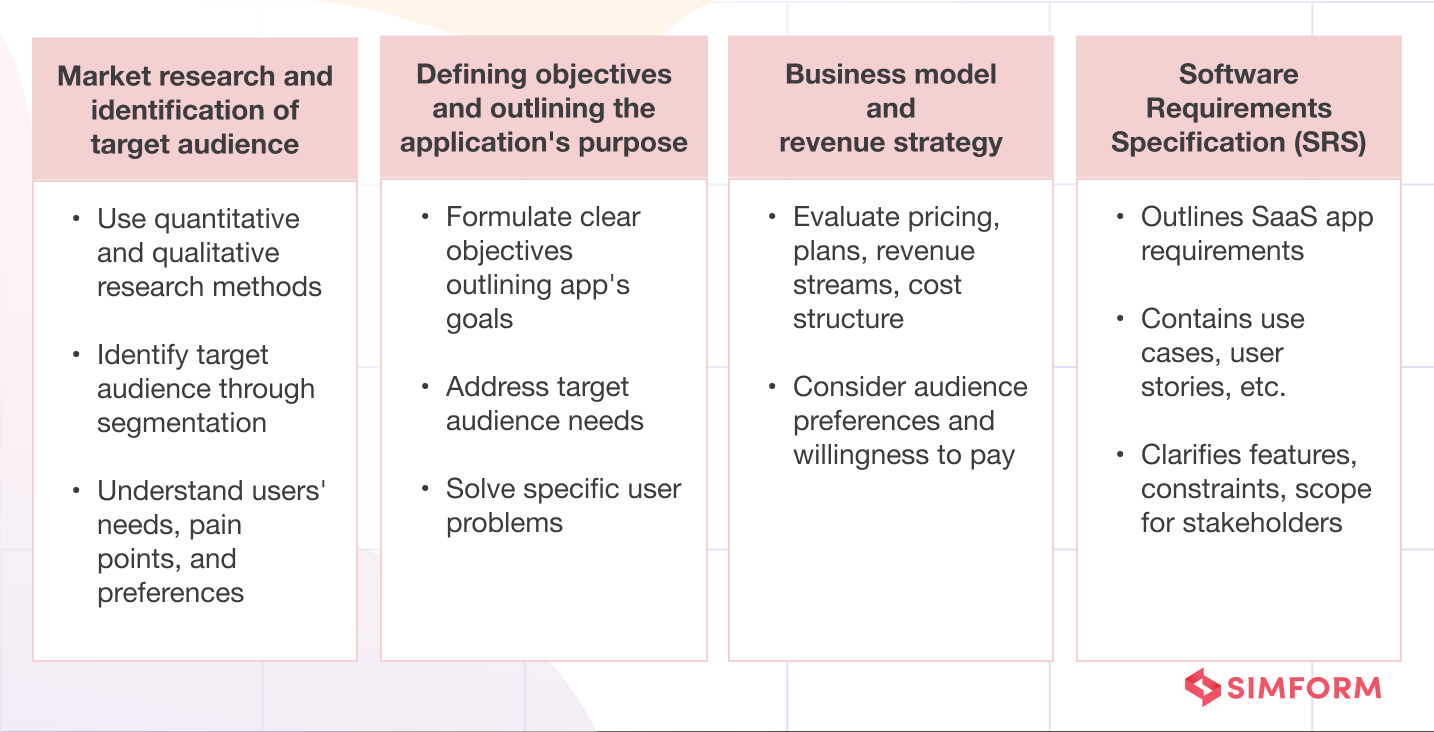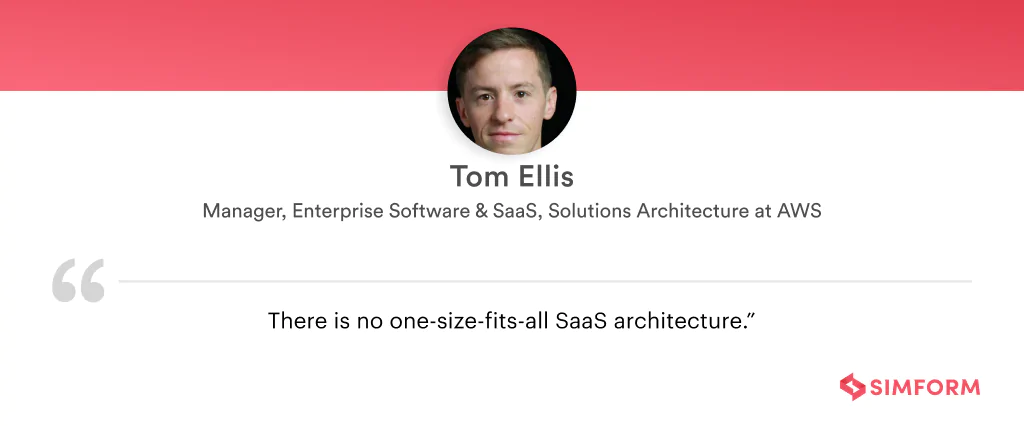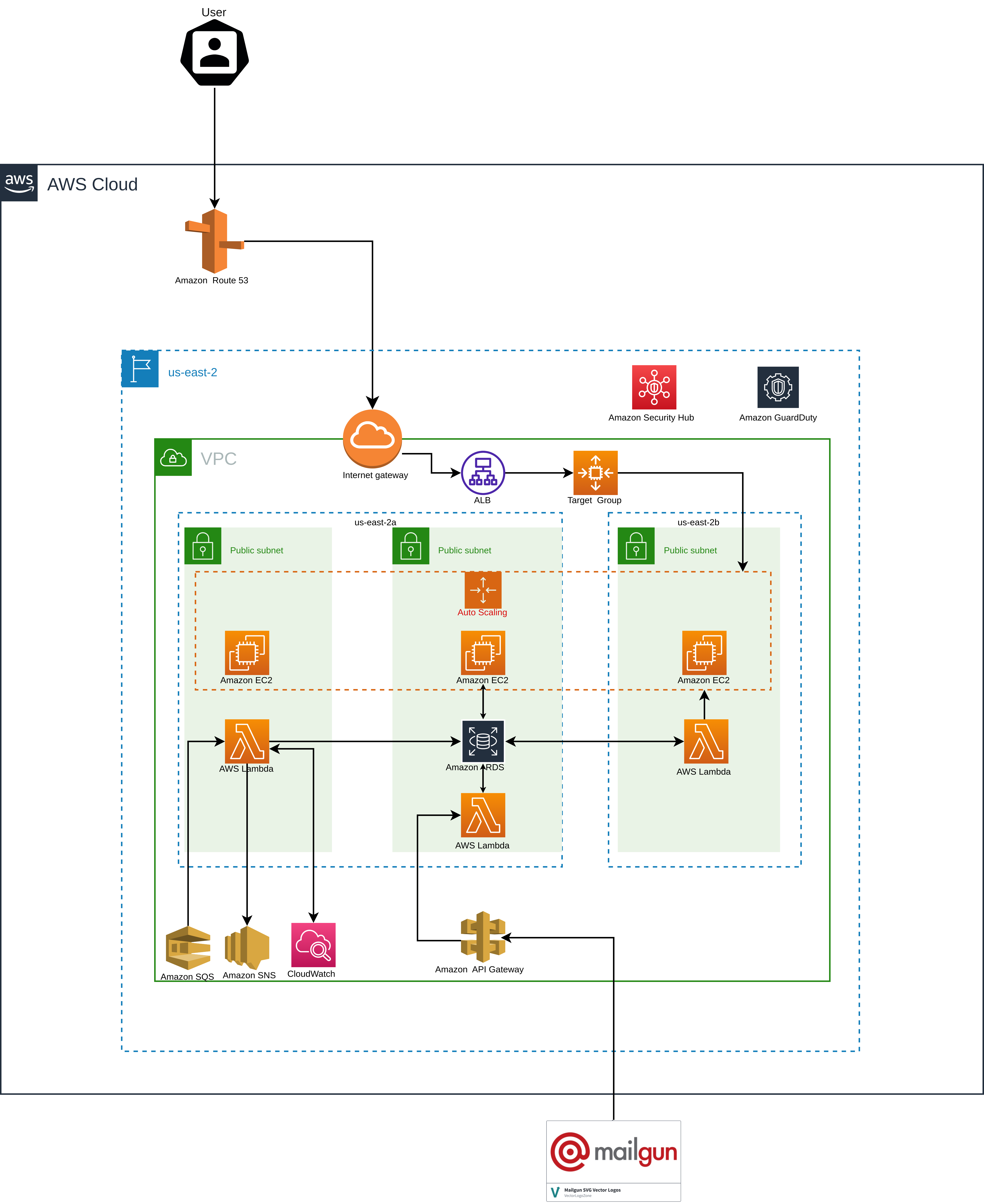The SaaS market, considered one of the most promising and rapidly expanding, is projected to increase from $273.55 billion in 2023 to $908.21 billion by 2030. The promise of recurring revenue streams and scalable customer reach continues to draw businesses to this booming market.
However, companies strategizing new software-driven offerings must first validate if their capabilities align with the SaaS model. Successful examples span ERP systems, project tools, collaboration platforms, marketing suites, B2C apps, streaming services, and e-learning.
After validation, the organizations should explore partnerships with leading cloud providers, as it enables seamless scalability, enhanced security, and ease of integration for these offerings. Among available options, AWS stands out as a reliable choice for hosting and managing SaaS applications, thanks to its extensive range of services and tools.
As an AWS Premier Consulting Partner who has also achieved SaaS competency, Simform excels in building efficient SaaS applications on AWS. In this article, we’ll provide a step-by-step guide on the role of AWS services in designing, developing, and deploying scalable and secure SaaS applications.
Why build SaaS on AWS?
AWS provides an overwhelming range of tools and capabilities ideal for developing and delivering secure, resilient SaaS applications. The AWS cloud is purpose-built for SaaS, with global infrastructure, compliance assurances, flexible services, and extensive enablement resources.
Here’s why AWS is preferred the most:
- Robust infrastructure spanning 102 availability zones across 32 geographic regions around the world, with announced plans for 15 more availability zones and 5 more AWS regions in Canada, Germany, Malaysia, New Zealand, and Thailand. This provides low-latency access for customers everywhere.
- End-to-end security measures and compliance with regulations like HIPAA, PCI DSS, and GDPR
- Choice of compute services, including EC2, ECS, Lambda, RDS, and more, to match needs
- Auto scaling, load balancing, and pay-as-you-go pricing for efficient resource optimization
- Continuous innovation of new capabilities (ML, IoT, etc.,) to create next-gen SaaS functionality
With the support of the AWS ecosystem, you can focus your efforts on delivering a differentiated SaaS experience for your subscribers.
Four-step process for building SaaS applications on AWS
Building SaaS applications requires a deep understanding of the unique requirements and complexities of delivering a high-quality, scalable, and cost-effective product.
While regular SaaS providers may be able to create functional applications, they often lack the necessary technical expertise and experience to tackle the various challenges that come with SaaS delivery. Meanwhile, AWS SaaS Competency Partners like us undergo a rigorous validation process, ensuring that we possess deep technical expertise and proven customer success in the SaaS domain.
As an Premier AWS Consulting Partner, Simform also holds other competencies in Advertising and Marketing Technology Services, Migration Consulting, and DevOps Consulting. With such a well-rounded skillset, we aim to deliver unparalleled service for our clients.
So, let’s explore how to build more reliable and higher-quality SaaS applications backed by AWS’s robust cloud infrastructure.
1. Discovery phase
The discovery phase of building a SaaS application involves several critical steps aimed at ensuring that the end product is well-suited for its intended market and target audience while aligned with the project’s objectives. In this phase, the goal is to lay a solid foundation on which developers can build a successful application. Here is a visualization of the key points during this stage:

The discovery phase ultimately helps to prevent unnecessary frustrations with the final product by identifying potential flaws and limitations early on, and resolving conflicting ideas about the project.
2. Architecture design
While deciding the application’s technical architecture, you need to identify the appropriate programming languages, frameworks, and platforms to be used. Decisions also need to be made regarding server infrastructure, database architecture, APIs, and third-party integrations, among other technological aspects.
AWS supports numerous programming languages, such as JavaScript, Python, Java, C#, Go, and Ruby. Select a language and framework based on your team’s expertise and the specific requirements of the SaaS application.

SaaS architecture can be divided in 2 broad categories based on industry and functionality coverage:
Vertical SaaS architectures cater to specific industries with tailored functionalities and services. For instance, BioIQ, specializing in digital health solutions for clinical research and patient care, is a vertical SaaS application.
Meanwhile, horizontal SaaS applications provide specific functions like marketing and sales across industries. For instance, Salesforce, a CRM software provider serving a diverse range of businesses across industries, exemplifies a horizontal SaaS application.
SaaS tenancy models based on component shareability
SaaS tenancy models are based on tenants, with each customer considered a tenant gaining access through a subscription fee. Single-tenant architecture offers unique designs for individual clients, emphasizing security and reliability. However, the term “single-tenant” is often avoided in SaaS contexts, favoring “multi-tenant” to describe shared or dedicated resource implementations.
The terms “silo” and “pool” clarify models in SaaS development, where “silo” designates dedicated resources for a tenant, and “pool” signifies shared resources. AWS provides multi-tenancy infrastructure, offering both dedicated single-tenant and mixed options with services like Amazon EC2.
How does AWS help in shaping multi-tenant SaaS applications?
- Infrastructure abstraction: With managed services like Amazon RDS, API Gateway, and Elastic Beanstalk, you can focus on designing the multi-tenant application without worrying about underlying infrastructure management.
- Account and resource tagging: AWS enables efficient resource organization and tracking through tagging, creating a clear separation of tenant-specific resources at the architectural level.
- Performance optimization: AWS Auto Scaling and Elastic Load Balancing help in designing architecture that can dynamically scale based on tenant workloads.
- Data storage and security: AWS provides multiple data storage services like Amazon S3, Amazon Aurora, and Amazon DynamoDB, which can be incorporated into the multi-tenant architecture.
- Network isolation: Through Amazon VPC, you can create isolated network environments for each tenant, effectively isolating their resources and protecting them from potential security threats in a shared architecture.
- Microservices architecture: AWS supports containerization and orchestration tools like Docker, Kubernetes, and Amazon ECS, which can improve scalability, fault tolerance, and agility.
Simform implementing a multi-tenant architecture to revolutionize automobile dealership sales
Simform was approached by a leading automobile company that provides digital marketing solutions to major car brands. They faced issues with multi-tenancy and security, high monthly expenses, data management difficulties, and API inefficiency.
To overcome these challenges, our experts
- Implemented a multi-tenant architecture with robust security features (user authentication, authorization, data encryption, and regular security audits).
- Optimized client’s AWS servers using compute optimization services, leading to a significant reduction in monthly AWS bills.
- Implemented lifecycle policies for the S3 bucket to optimize storage costs without compromising data availability.
- Addressed API inefficiencies by making changes to the API and implementing host-based routing on a specific server for improved load distribution, enhancing system performance, and reducing downtime.
Architecture diagram

Ultimately, our client achieved a 52% reduction in costs, a 400% increase in efficiency, a 113% boost in sales, and an impressive 99.9% system uptime through our implemented solution.
How does AWS help in architecting serverless SaaS applications?
As SaaS applications strive for agility while managing escalating server costs, many organizations turn to serverless architectures on AWS. Despite its inherent power, the serverless application quickly loses its charm when improperly architected.
- Stateless components: AWS encourages stateless component design for easy horizontal scaling.
- Fine-grained microservices: AWS promotes a microservices architecture, with each service as an independent AWS Lambda function. This allows for individual development, testing, deployment, and scaling
- Event-driven data pipelines: Amazon EventBridge, SNS, and SQS enable event-driven data pipelines, decoupling services and fostering asynchronous communication. This approach enhances system resilience and flexibility, reducing latency for end users.
- Distributed caching: In serverless SaaS architectures, AWS provides managed caching services like Amazon ElastiCache, which can be used to effectively store and manage frequently accessed data.
- Multi-tenancy patterns: AWS facilitates diverse multi-tenancy patterns for serverless SaaS apps, such as pooled, siloed, and bridge models via Amazon Cognito and Amazon API Gateway. These models ensure data isolation, security, and scalability.
3. Development and testing
This step involves coding, integration, validation, and debugging to make sure your application runs smoothly. AWS offers a variety of tools and services to help you streamline your frontend and backend development processes, as well as testing and debugging.
Frontend development: UI/UX design
A successful SaaS application starts with a well-designed user interface and a delightful user experience. AWS provides tools and services to accelerate UI/UX design and development, making it a smooth and enjoyable process for every stakeholder.
Multi-tenant SaaS applications [Frontend development]
- Coding: AWS Amplify empowers developers to build and deploy scalable, secure frontend applications with built-in libraries and UI components for React, Angular, and Vue.js, adhering to coding best practices and optimal application structuring.
- Integration: AWS App Runner and AppMesh simplify frontend integration with backend microservices and containers, streamlining data communication and enhancing end-to-end application performance.
- Custom UI/UX design: AWS Amplify Studio offers a visual development environment to design personalized UI components and themes, enabling the creation of responsive, adaptive layouts.
- Collaboration: AWS CodeStar and CodeCommit support collaborative frontend development through robust version control, issue tracking, and code review tools.
Serverless SaaS applications [Frontend development]
- Coding: AWS CDK helps define customizable serverless infrastructure using familiar programming languages like TypeScript, JavaScript, Python, and more.
- Integration: AWS EventBridge and Amazon SNS seamlessly integrate frontend applications with serverless backend services, triggering real-time events and notifications.
- UI/UX design: AWS Amplify Console simplifies building and deploying SaaS applications with custom domains, HTTPS, continuous deployment, and integration with popular web frameworks for intuitive UI/UX designs.
- Testing and debugging: AWS Step Functions, Amazon X-Ray, and AWS Lambda extensions allow the designing, testing, and debugging of serverless applications by providing powerful visualization tools and facilitating granular application monitoring.
Backend development: Infrastructure and services
AWS’ durable infrastructure enables the smooth and productive functioning of your SaaS application’s backend by governing key backend entities like databases, processing, and storage. Also, the broad global infrastructure allows SaaS applications to be deployed in multiple regions for better performance and lower latency.
Multi-tenant SaaS applications [Backend development]
- Managed database services: Amazon RDS and DynamoDB helps streamline database provisioning, scaling, and management, empowering developers to focus on building application logic.
- Elastic Beanstalk deployment: AWS Elastic Beanstalk simplifies deploying, scaling, and managing multi-tenant SaaS applications, enabling developers to effortlessly deploy code, oversee infrastructure, and utilize monitoring tools.
- Serverless backend development: AWS Lambda and other serverless services enable the separation of application logic and computing resources, ensuring multi-tenant isolation.
Serverless applications [Backend development]
- Serverless application development: AWS Lambda enables developers to focus on writing application logic without the need for provisioning or managing servers, allowing the creation of serverless applications that respond to events efficiently.
- Simplified resource definition: AWS Serverless Application Model (SAM) streamlines the process of defining, deploying, and managing serverless applications through templates that include Lambda functions and API Gateway configurations.
- Workflow orchestration: AWS Step Functions facilitates the coordination of Lambda functions and other AWS services to automate complex workflows in serverless applications, reducing custom code requirements.
- API management: Amazon API Gateway expedites serverless application development by offering an accessible platform for creating, publishing, and managing RESTful and WebSocket APIs, including support for custom domain names and SSL certificates.
- Integrated monitoring and development tools: AWS offers a suite of tools, such as AWS X-Ray, Amazon CloudWatch, and AWS CodePipeline, for efficient application integration, monitoring, and deployment in serverless environments.
- Streamlined deployment and management: AWS SAM simplifies serverless application deployment and management with template-based resource definitions and built-in local testing and debugging features.
- Edge case testing for APIs: Amazon API Gateway and AWS AppSync enable developers to effectively build, deploy, and manage serverless application APIs, supporting realistic API call simulations and efficient debugging.
By streamlining your frontend and backend development, and implementing rigorous testing and debugging processes with AWS, you can ensure a successful launch and ongoing user satisfaction.
4. Maintenance and further development
Maintaining a SaaS application post-development is crucial for optimizing performance, ensuring security and compliance, and addressing bugs and enhancements. As user bases expand and features evolve, ongoing performance optimization helps deliver a seamless user experience across devices and platforms.
SaaS applications store and process sensitive customer data, making it critical to provide regular updates that address potential security vulnerabilities. Bug fixes, feature improvements, and scalability adjustments are important to meet customer expectations and adapt to increasing workloads.
And then, SaaS applications often need to integrate with other third-party services, APIs, and software packages. Regular maintenance helps to ensure seamless compatibility and offers support for new integrations, reducing the risk of technical issues arising from software dependencies.
This is how AWS helps maintain SaaS applications in several ways:
- Integration: AWS provides managed services, SDKs, APIs, and tools for seamless integration of SaaS applications with AWS services and third-party applications. This enables smooth data exchange, analytics, machine learning capabilities, and more.
- Security: AWS provides various security features, such as AWS Identity and Access Management (IAM) for fine-grained permissions, encryption of data at rest and in transit, and Amazon Inspector for security vulnerability assessments. AWS data centers also comply with global standards and certifications, ensuring data privacy, protection, and regulatory compliance.
- Monitoring and management: AWS offers numerous monitoring and management services like Amazon CloudWatch, AWS X-Ray, and AWS AppConfig to track app performance, identify issues, and manage configurations effectively.
- Deployment and scaling: AWS enables easy deployment, scaling, and load balancing of SaaS applications through services like AWS Elastic Beanstalk, AWS Lambda, and Amazon EC2 Auto Scaling. This ensures optimal performance under heavy workloads.
If further changes are needed, SaaS application developers can introduce new features, enhancements, updates, and bug fixes without disrupting the entire system. They can leverage AWS services like AWS CodeStar, AWS CodePipeline, and AWS CodeDeploy to manage the software development process and implement continuous integration and delivery pipelines, minimizing downtime and providing a seamless user experience.
With AWS’s powerful capabilities and resources, you can streamline your SaaS application’s development process. However, navigating the early stages of developing a SaaS application can be a daunting task for any business, especially when faced with a multitude of decisions that can impact the entire project. It is essential to pay close attention to relevant factors, such as simplifying third-party integrations, and understanding crucial regulations like GDPR early on in the process.
Find out more as the experts discuss various approaches to tackling SaaS projects that require live streaming, IoT, and multi-tenant white labeling, emphasizing the diverse challenges involved in implementing a clean and scalable SaaS solution.
Simform boosting field services efficiency with a comprehensive SaaS solution
One of our clients, a leading U.S. AV/IT service organization, wanted to create a secure and efficient SaaS solution to streamline their field services management.
They faced multiple challenges with their manual, paper-based processes, including inefficient task tracking, low reliability from excessive workloads, high operational costs, and the need for a secure, highly available infrastructure.
Solution & architecture:
Simform devised a comprehensive solution, transforming the client’s field services management by:
- Creating an efficient, user-friendly system that eliminated common issues, automated workflow, and saved 60-80% of the client’s time on administrative tasks.
- Ensuring seamless integration with popular third-party tools to reduce the learning curve for new users.
- Providing high availability, scalability, and security with a modern tech stack based on various AWS services and implementing strict data protection measures.
The implemented platform achieved widespread adoption by over 20 organizations in the United States, enhancing task management and reporting, ensuring high availability and scalability, and facilitating a smooth transition with seamless integration into third-party tools.
Build your SaaS application on AWS with Simform
SaaS applications can be costly to maintain and scale for multiple tenants despite the promised flexibility. So, it’s necessary to optimize the cost of multi-tenant SaaS applications. The AWS Pricing Calculator helps estimate SaaS application architecture costs, considering service selection, configuration, usage patterns, data transfer, custom pricing, and offering optimization suggestions.
Building an effective SaaS application requires partnering with a company well-versed in best practices and modern tools. Our team comprises 200+ AWS-certified professionals with extensive certification, including AWS Certified Solutions Architect, Cloud Practitioner, SysOps Administrator – Associate, DevOps Engineer, and more.
AWS Certified Solutions Architects utilize their expertise in designing robust, affordable cloud architectures to architect SaaS apps on AWS. By applying the AWS Well-Architected Framework, collaborating with AWS experts, and employing SaaS best practices and tools, they architect cost-optimized, reliable, and scalable SaaS solutions.
From selecting the right architecture and utilizing essential services like Amazon RDS, AWS Lambda, and Amazon S3, to implementing best practices for monitoring and maintaining the application, we’ll cover everything you need to know to build a robust SaaS product on AWS. Let’s get connected!